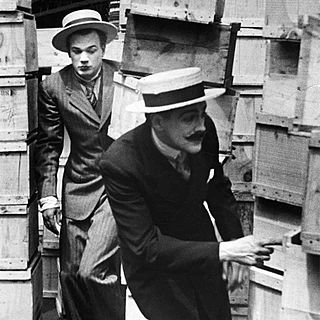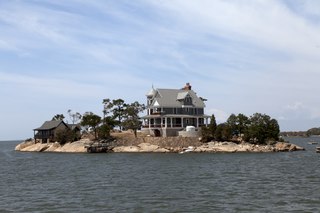
Branford is a shoreline town located on Long Island Sound in New Haven County, Connecticut, United States, about 6 miles (10 km) east of downtown New Haven. The town is part of the South Central Connecticut Planning Region. Branford borders East Haven to the west, Guilford to the east, and North Branford to the north. The population was 28,273 in the 2020 census.

Puppetry is a form of theatre or performance that involves the manipulation of puppets – inanimate objects, often resembling some type of human or animal figure, that are animated or manipulated by a human called a puppeteer. Such a performance is also known as a puppet production. The script for a puppet production is called a puppet play. Puppeteers use movements from hands and arms to control devices such as rods or strings to move the body, head, limbs, and in some cases the mouth and eyes of the puppet. The puppeteer sometimes speaks in the voice of the character of the puppet, while at other times they perform to a recorded soundtrack.

A marionette is a puppet controlled from above using wires or strings depending on regional variations. A marionette's puppeteer is called a marionettist. Marionettes are operated with the puppeteer hidden or revealed to an audience by using a vertical or horizontal control bar in different forms of theatres or entertainment venues. They have also been used in films and on television. The attachment of the strings varies according to its character or purpose.

Bunraku is a form of traditional Japanese puppet theatre, founded in Osaka in the beginning of the 17th century, which is still performed in the modern day. Three kinds of performers take part in a bunraku performance: the Ningyōtsukai or Ningyōzukai (puppeteers), the tayū (chanters), and shamisen musicians. Occasionally other instruments such as taiko drums will be used. The combination of chanting and shamisen playing is called jōruri and the Japanese word for puppet is ningyō. It is used in many plays.

Avenue Q is a musical comedy featuring puppets and human actors with music and lyrics by Robert Lopez and Jeff Marx and book by Jeff Whitty. It won Best Musical, Book, and Score at the 2004 Tony Awards. The show's format is a parody of Sesame Street, but its content involves adult-oriented themes. It has been praised for its approach to themes of racism, homosexuality and internet pornography.

The Mercury Theatre was an independent repertory theatre company founded in New York City in 1937 by Orson Welles and producer John Houseman. The company produced theatrical presentations, radio programs and motion pictures. The Mercury also released promptbooks and phonographic recordings of four Shakespeare works for use in schools.

Stony Creek is a coastal village located the southeastern section of Branford, Connecticut, centered on a harbor on Long Island Sound. Stony Creek has the ambiance of a small seaside village which retains its roots as a summer vacation location with old Victorian hotels and a working granite quarry. It is known for the Thimble Islands an archipelago of glacial rocks, ranging from 17 acres (6.9 ha) down to stepping-stone size, at the harbor's mouth. Despite their small size, they possess a wealth of history and local lore, as well as providing pleasant scenery. The islands are privately owned but visitors may get an up-close view via several tour boats which run in the spring, summer and autumn. In the past, Stony Creek was also known for lobstering and oystering, but these industries have all but vanished in recent decades.

Too Much Johnson is a 1938 American silent comedy film written and directed by Orson Welles. An unfinished film component of a stage production, it was made three years before Welles directed Citizen Kane, but it was never publicly screened. It was shot to be integrated into Welles's Mercury Theatre stage presentation of William Gillette's 1894 comedy, but the film sequences could not be shown due to the absence of projection facilities at the venue, the Stony Creek Theatre in Connecticut. The resulting plot confusion reportedly contributed to the stage production's failure.

Toy theater, also called paper theater and model theater, is a form of miniature theater dating back to the early 19th century in Europe. Toy theaters were often printed on paperboard sheets and sold as kits at the concession stand of an opera house, playhouse, or vaudeville theater. Toy theatres were assembled at home and performed for family members and guests, sometimes with live musical accompaniment. Toy theatre saw a drastic decline in popularity with a shift towards realism on the European stage in the late 19th century, and again with the arrival of television after World War II. Toy theatre has seen a resurgence in recent years among many puppeteers, authors and filmmakers and there are numerous international toy theatre festivals throughout the Americas and Europe.

Money Island is one of the Thimble Islands off Stony Creek, a section of Branford, Connecticut. It is named after a legend that Captain Kidd buried his treasure there. The island, 12 acres in size, bears an entire village of 32 houses, a post office, and one library. Former buildings included a school, a church, and a grocery store. There are three roads and several piers. At this time, none of the houses are occupied year-round.
Davis Island, one of the Thimble Islands off Stony Creek, a section of Branford, Connecticut, was the site of President William Howard Taft's "Summer White House".
Mother-in-Law Island is an island in the Thimble Islands group, part of the Stony Creek–Thimble Islands Historic District on Long Island Sound in Branford, Connecticut. It is also known as Johnson Island, Prudden Island, and Little Stooping Bush. One house, a frame-structured house built around 1965, stands on the island.
The Long Christmas Ride Home is a one-act play written by Paula Vogel. It dramatises a road trip by two parents and their three young children to visit grandparents for Christmas dinner, and the emotional turmoil that they undergo. A significant element of the production schema is a Western contemporary employment of bunraku.

Around the World is a musical based on the 1873 Jules Verne novel Around the World in Eighty Days, with a book by Orson Welles and music and lyrics by Cole Porter. It involves an around-the-world adventure by Phileas Fogg. The expensive musical extravaganza opened on Broadway in May 1946 but closed after 75 performances.

The Branford Steam Railroad is a 7.2-mile (11.6 km) standard-gauge industrial railroad that serves the Tilcon Connecticut stone quarry in North Branford, Connecticut, in the United States. It was founded in 1903 by Louis A. Fisk, a businessman from Branford, Connecticut, to transport passengers to a trotting park for horses. Fisk also chartered the Damascus Railroad in 1905 to extend the route of the Branford Steam Railroad to North Branford to serve quarries. The Damascus Railroad's charter was amended in 1907 to allow a further extension to the site of a new quarry adjacent to Totoket Mountain. The Branford Steam Railroad took control of the Damascus Railroad in 1909, and has been the operator since.

The Stony Creek–Thimble Islands Historic District is a historic district encompassing a 19th-century summer resort area in Branford, Connecticut. Located in the southeastern part of the town, it encompasses the mainland Stony Creek neighborhood, and all of the major Thimble Islands which lie offshore from Stony Creek in Long Island Sound. The district includes a well-preserved array of domestic summer resort architecture spanning more than a century preceding World War II, as well as worker housing and other artifacts related to the area's brief importance as a granite quarry. The district was listed on the National Register of Historic Places in 1988.

A puppet is an object, often resembling a human, animal or mythical figure, that is animated or manipulated by a person called a puppeteer. Puppetry is an ancient form of theatre which dates back to the 5th century BC in ancient Greece.

The William J. Clark House is a historic house at 32 Prospect Hill in the Stony Creek neighborhood of Branford, Connecticut. Built in 1878–80 to a design by New Haven-based architect Henry Austin, it is a particularly fine example of the Stick style of architecture popular at the time. The house is individually listed for its architecture on the National Register of Historic Places as the Stick Style House at Stony Creek, and is a contributing property to the Stony Creek-Thimble Islands Historic District.

The Thimble Islands is an archipelago consisting of small islands in Long Island Sound, located in and around the harbor of Stony Creek in the southeast corner of Branford, Connecticut. The islands are under the jurisdiction of the United States with security provided by the town of Branford police and the US Coast Guard.

Bialystok Puppet Theatre , founded in 1953, is one of the oldest puppet theaters in Poland. Its repertoire consists mainly of puppetry-based adaptations of international literature, as well as children's entertainment.


















